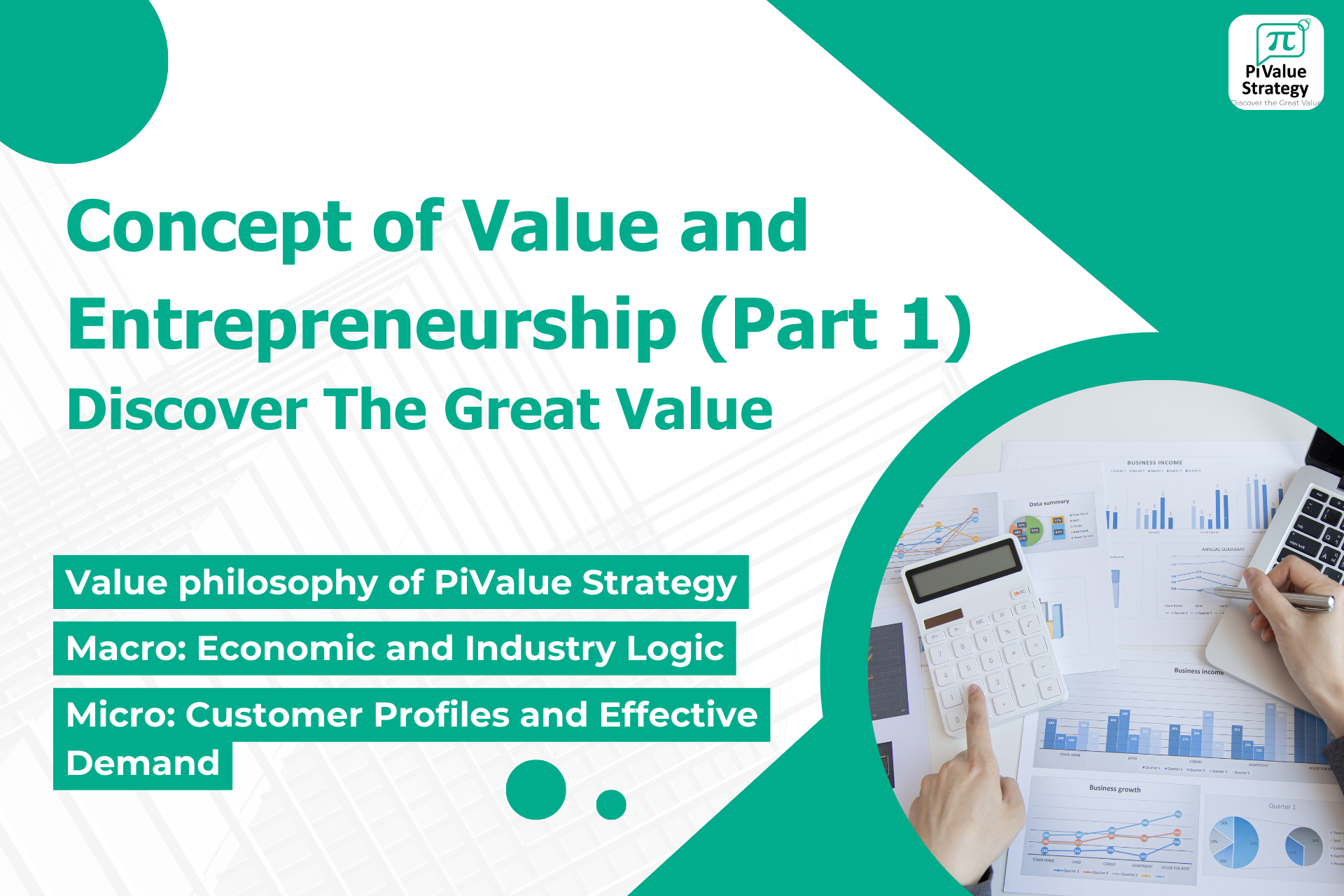Discovering Great Value is our driving force at PiValue. We often express our commitment to discovering, creating, and realizing value. We aim to collaborate with enterprises focused on creating significant and meaningful social value or industry innovation, striving to foster unicorns or publicly listed companies that generate lasting value for society and their respective fields.
To this end, we provide support to startups and small to medium-sized enterprises in three key areas:
- Conducting macro and micro analysis to identify existing and potential business and social value and innovation, thereby uncovering value.
- Exploring business models to seek breakthroughs and achieve goals and visions, thereby creating value.
- Implementing execution systems to gradually carry out action plans, supervise, and review, thereby realizing value. We also regularly review the seven dimensions of the company to build organizational strength.
Macro: Economic and Industry Logic
When discussing value from a macro perspective, it involves identifying the fundamental driving forces from economic principles and industry logic to develop a model and strategic direction to capture value.
Economic and Capital Trends
From the energy revolution, industrial revolution, and information revolution to the current AI and new energy revolution, each wave of change has swept in like a tsunami. We may not need to see the fine details, but it is often difficult for ordinary entrepreneurs to navigate these waves.
Historically, the famous tycoon John D. Rockefeller was known for his keen business insight and ability to seize historical opportunities. After the American Civil War, Rockefeller, already wealthy, sought the next big opportunity. At the time, Pennsylvania discovered large quantities of oil, dubbed “liquid gold.” Rockefeller astutely realized this would be a huge market. However, due to the vast opportunities, oil companies sprang up rapidly, leading to intense industry competition. Rockefeller understood that the core competitiveness of the oil industry was not the oil itself but the ability to transport it, as extracted oil needed to be shipped nationwide. Thus, whoever controlled the railroads controlled the oil industry.
The leading figure in the railroad industry was the Vanderbilt family. Rockefeller demonstrated extraordinary courage and negotiation skills, proposing attractive cooperation terms and successfully partnering with the Vanderbilts. This strategic cooperation gave Rockefeller an advantageous position in the fierce oil industry competition. By controlling the transportation lifeline of oil, Rockefeller not only dominated the industry but also began the illustrious chapter of his business empire. This history showcases Rockefeller’s business talent and his ability to seize opportunities and make decisive decisions at critical moments.
The value formed by trends is immense, as the fundamental is build upon overall social needs. The key for entrepreneurs to seize opportunities is to face, accept, understand, and ultimately use them. Innovation is crucial. Behind every revolution is a myriad of accumulated innovations and breakthroughs. Entrepreneurs is encouraged to try new technologies and models, cultivate an internal culture of innovation, and encourage teams to continually challenge existing business models and seek new growth points.
Moreover, as seen in the cooperation between Rockefeller and the Vanderbilt family, building strong cooperative networks is essential to capturing trends. In the modern business environment, the era of solo operations is over. Entrepreneurs should actively seek cooperation with other businesses, integrate resources, and jointly promote industry development.
Industry Logic and Data Trends
In business innovation, deep insights into industry nuances to find new value are particularly critical. Take serial entrepreneur Zhuang ChenChao, for instance. His success stems from his ability to discover underutilized business opportunities within industry logic. When founding Qunar and Bianlifeng, Zhuang did not follow popular trends but instead identified entry points through meticulous market logic analysis and data research.
First, he conducted a detailed analysis of the travel industry, identifying issues within the multi-layered distribution system and, based on this, found opportunities to offer differentiated services through building a Minimum Viable Product (MVP) and dissecting the value chain. In the Bianlifeng project, Zhuang redefined the convenience store model using algorithms and data analysis, achieving efficient operations and personalized sales strategies through data-driven supply chain optimization and tailored sales tactics.
This method emphasizes identifying commercial potential through technology and data insights from industry details, finding new growth points and value creation opportunities in a competitive market. Zhuang’s case demonstrates that understanding and redefining industry rules is an effective strategy for discovering new business value.
Understanding an industry deeply requires attention to both changes and constants. Only by recognizing changes can one identify what remains constant and core. 7-Eleven Japan’s founder, Toshifumi Suzuki, captured the essence of the convenience store industry as the unchanging need for convenience. He believed the real challenge lay in meeting diverse customer needs, not merely competing with other brands. This thinking defined the modern convenience store. Hence, 7-Eleven not only sells meals and bento but also provides ATMs, recharge services, magazines, and other daily necessities and services, becoming a community terminal service that allows customers to meet their daily needs in one stop with minimal time.
Micro: Customer Profiles and Effective Demand
What is discovering value on a micro level? We can examine it in two parts: first, fundamentally exploring what value is by understanding what effective demand is; second, examining the most valuable parts of the current business model, then analyzing whether the current model addresses the discovered value and if any reforms are needed.
[Value = Effective Demand = Real Demand x Willingness to Pay ]
Real Demand
We often vaguely believe the market demands our products and services, tending to overestimate the effectiveness of the demand. We think our products are the best and many will want them, providing us with a sense of certainty. However, when market responses and performance fluctuate, it brings us back to reality.
We need further analysis to precisely identify which specific needs we are serving, enabling us to more accurately meet these needs, discover potential demands, optimize marketing strategies, and continuously improve and innovate.
Effective demand refers to the demand customers are genuinely willing to purchase or pay for. Meeting these demands can bring commercial value and competitive advantage to the enterprise. By deeply understanding customers and identifying and meeting their effective demands, businesses can better fulfill market needs and enhance competitiveness.
Micro: Analyzing Customer Behavior, Pain Points, Itch Points, and Emotional Value
Understanding customers’ true needs involves a comprehensive analysis of their behavior, pain points, itch points, and emotional value. By observing customers’ behavior patterns and preferences during the purchasing process, we can identify their deep needs to address specific issues (pain points) and non-essential but desirable needs (itch points), while also understanding the emotional value products or services bring them. This multi-dimensional analysis helps businesses accurately pinpoint customers’ effective needs and design products or services that resonate emotionally, solve practical problems, and exceed expectations, thus creating products or services customers are willing to pay for.
Willingness to Pay (Price) or Rent
When discussing effective demand, we not only focus on whether consumers are willing to buy but more importantly, the price they are willing to pay. This seems obvious, but the complexity lies in the perception that some industries seem highly profitable, with consumers always willing to pay regardless of the price. Some lament that although milk tea prices exceed RM10, people rush to buy it, while bottled water priced at RM5 is considered expensive. Some netizens even say, “Some actors’ fees are hundreds of times higher than scientists, what social value have they created?” We can reflect on why actors are so valuable.
In discussing real demand, we mentioned pain points, itch points, and emotional value. Generally, the more significant the pain point, the more willing people are to pay more, provided supply is relatively scarce; the larger the problem solved or the satisfaction achieved, the more willing people are to pay more; the greater the emotional value, the more willing people are to pay more. This is because when a product or service can effectively solve consumers’ real problems, its value increases in consumers’ minds. For example, a smart watch providing precise health data is far more valuable to those pursuing a healthy lifestyle than an ordinary watch, hence they are willing to pay a higher price.
However, there are situations where emotional value is high but difficult to monetize – such as reaction videos, which, aside from advertising revenue, are generally hard

